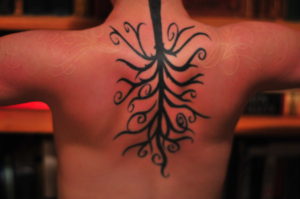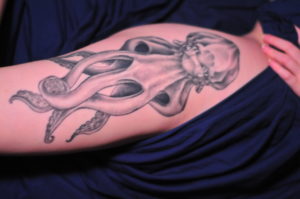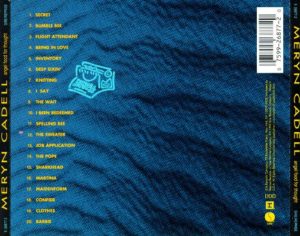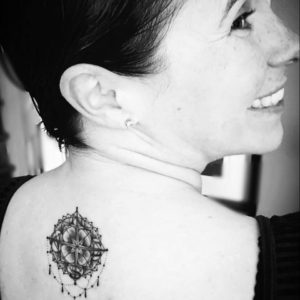
Hugo and Campbell award finalist Sarah Gailey is an internationally-published writer of fiction and nonfiction. Her nonfiction has been published by Mashable and the Boston Globe, and she is a regular contributor for Tor.com and Barnes & Noble. Her most recent fiction credits include Mothership Zeta, Fireside Fiction, and the Speculative Bookshop Anthology. Her debut novella, River of Teeth, comes out in May 2017. She has a novel forthcoming from Tor Books in Spring 2019. Gailey lives in beautiful Oakland, California with her husband and two scrappy dogs. You can find links to her work at www.sarahgailey.com; find her on social media @gaileyfrey.
The first time I met Chamuco, I took my shirt off and he traced the outline of my back onto a sheet of paper and we talked about the shape of the universe. The design I wanted was stark, simple, and infinite.
Everyone wants to know what it is and what it means. The amount of explaining I do largely depends on who is asking.
Random guy at a festival who grabs me by the shoulder so his friend can take a photograph of my back gets “not your fucking business.”
Stranger at a con who asks politely, interrupting a conversation I’m having with a friend gets “it’s a tree.”
Casual acquaintance gets “it’s tree roots.”
Friend who I dearly love and who has just purchased me my third glass of champagne gets this:
Dendritic patterning is a motif that is already intrinsic to my body. It’s the pattern that’s found in neurons, and lungs, and blood vessels. It’s also the pattern that’s in tree branches, and lightning, and river deltas. It represents my faith. It represents the way that my past connects to my future. It represents the infinite smallness and infinite largeness of everything I am and everything I do. It represents all the terrible things in my life, and the way all of those terrible things came together to point to a path that I’m glad to be on, and the way all of those things will eventually prove to be small in the great scope and scale of my life.
The first time I met Chamuco, I told him what I wanted, and he responded with a sketch that filled the top third of my back. The session took four and a half hours. Chamuco started at the bottom and worked his way up. I braced my arms against the back of a plastic-wrap-covered office chair and told him about my life as he worked. At the very top of the piece, he shaved off part of my hair with a straight razor. The tattoo needle made my skull vibrate so hard that my vision blurred, and I saw what pain feels like.
When I came back, Chamuco put an octopus on my thigh.

I trusted him by then. I trusted him so much that I indicated a span of flesh ranging from the top of my pelvis to the top of my knee, and I said “put an octopus there, whatever you want.” Chamuco was pretty excited — it turns out he’d spent days and nights at the Monterey Bay Aquarium studying the way tentacled creatures move. He gave me my second tattoo in another 4-hour session.
I didn’t come back again for five years or so. I’d gotten a lot of skin covered in a short time. I didn’t want anything else yet. I sent friends and family to Chamuco, and I kept up with him on social media, and I followed his artistic career as much as I could. It felt like a shorter time than it really was.
When I came back, I wanted my upper arms covered. They had scars on them, and they embarrassed me in that way that things only you ever notice can be embarrassing.
“What do you want?” he asked me, after we caught up a little.
“White ink,” I said. I liked the way it looked, and I liked how it would make my scars blend in. “Something that will go with my back piece. Whatever you want.”
I was wearing a strapless dress, and I rolled it down so that Chamuco could see my back piece. I stood with my arms outstretched as he drew on my skin, freehand, with a sharpie. I looked in the mirror at the curling, lacy wings he was applying to my shoulders and upper arms, and I smiled. I asked for one small adjustment — a curl where there was a straight line — and within a couple of hours the filigree was permanent.
I came back a week later for touch-ups on my back and thigh, and I realized how good I had it — that I could come to someone and ask them for something that would be on my skin forever, and I never once had to worry about whether or not I’d love it. Chamuco’s additions make me feel like art. When River of Teeth comes out in May, I’ll be sporting a new piece — a blood-spattered water hyacinth. I won’t know what it looks like until it’s finished. I won’t know what he has planned for me until it’s done — but I know it’ll be good.
It always is, in the end.
About this post: Inksplanations (and variations thereon) is the name for a series of short interviews with a number of genre writers about their tattoos. Why they got them, what they mean, how getting ink did or didn’t change them–any and all of these topics are fair game. What drives a literary artist to literally become canvas for an image or epigram? Did they get what they were seeking? I wanted to know, especially after I got my 2016 poppies from Toronto artist Lorena Lorenzo at Blackline Studio, and so I did what any curious writer would do. I asked.




 Laura Anne Gilman is the Nebula- and Endeavor-award nominated author of
Laura Anne Gilman is the Nebula- and Endeavor-award nominated author of 






 It was a Saturday sometime in August and I was on Queen Street, schlepping home the sandwich we favor for weekend lunch. The weather was glorious, late-summer heat and all the sun you could wish for. Thanks to the particular perversity of the retail ecosystem, one of the clothing boutiques had a fall coat in the window.
It was a Saturday sometime in August and I was on Queen Street, schlepping home the sandwich we favor for weekend lunch. The weather was glorious, late-summer heat and all the sun you could wish for. Thanks to the particular perversity of the retail ecosystem, one of the clothing boutiques had a fall coat in the window.